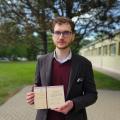Paieška
2024. 09. 12
-
R. Petkevič, who develops 3D printing technologies, becomes a PhD
Romuald Petkevič, a physicist at the FTMC Department of Laser Technologies, is the new Doctor of Technology! He successfully defended his thesis on "Development and Application of Laser Sintering Technology for Metallic Particles" (academic supervisor: Dr. Genrik Mordas).
Congratulations to our colleague and best wishes for every success!
Romuald's work is related to 3D printing, also known as additive manufacturing. FTMC is conducting research in this field, and the new PhD was aimed at improving the laser metal deposition (LMD) method of such printing, which is available on the market, by providing more precision.
In the LMD process, the starting material (usually a metal powder) is typically laser melted and deposited on a substrate. This produces a new metal object.
"3D printing produces very rough and coarse parts (which is good for large objects), and in order to make them more precise, it requires removing quite a large layer of metal from the surface through machining. So my work was designed to remove less of that layer," says the physicist.

(Moment of PhD defence. Photo from personal archive)
For this purpose, he and his team were the first in the world to combine two technologies used by LMD:
"We used laser heating - where the surface of the material becomes very soft or melts away - and then applied cold spray, where particles of a soft metal such as copper or aluminium are sprayed at supersonic speeds. In our case, the cobalt-chromium-molybdenum metal alloy particles entered the surface of the steel substrate (exposed to the laser beam) and became trapped there, forming a new layer."
This is done with a special nozzle that Romuald and his colleagues have developed and approved. Where could this innovation be used? "I can see its application in the automotive (or any other) industry, in the restoration of various parts where welding does not always achieve results. With our technology, it would be possible to apply an additional layer of metal and rebuild or restore the material with a minimum of post-processing," the researcher reflects.
He adds that the improved LMD printing process has reduced the surface roughness of the materials to 4 micrometres (thousandths of a millimetre). This is a really significant difference compared to other technologies, which produce surface roughness of 10-13 micrometres.
FTMC information
Susiję:

2024. 06. 19
-
FTMC PhD student M. Gaidys' presentation recognized as the best in Spain for the second consecutive year
This is a great international recognition of the entire Lithuanian laser technology sector.
-0f0d761c933fd75151c1176e0c6f1bb6.jpg)
2024. 05. 31
-
FTMC engineer A. Černeckytė, who studies ultrashort pulse lasers, receives an award at the International Photonics Conference
The youngest participant in the event was awarded for the best oral presentation in the laser section!

2024. 05. 16
-
G. Liaugminas, a laser scientist working on fiber optics, is a new PhD
His research has led him to become more interested in quantum communication - and to continue his work in this direction.

